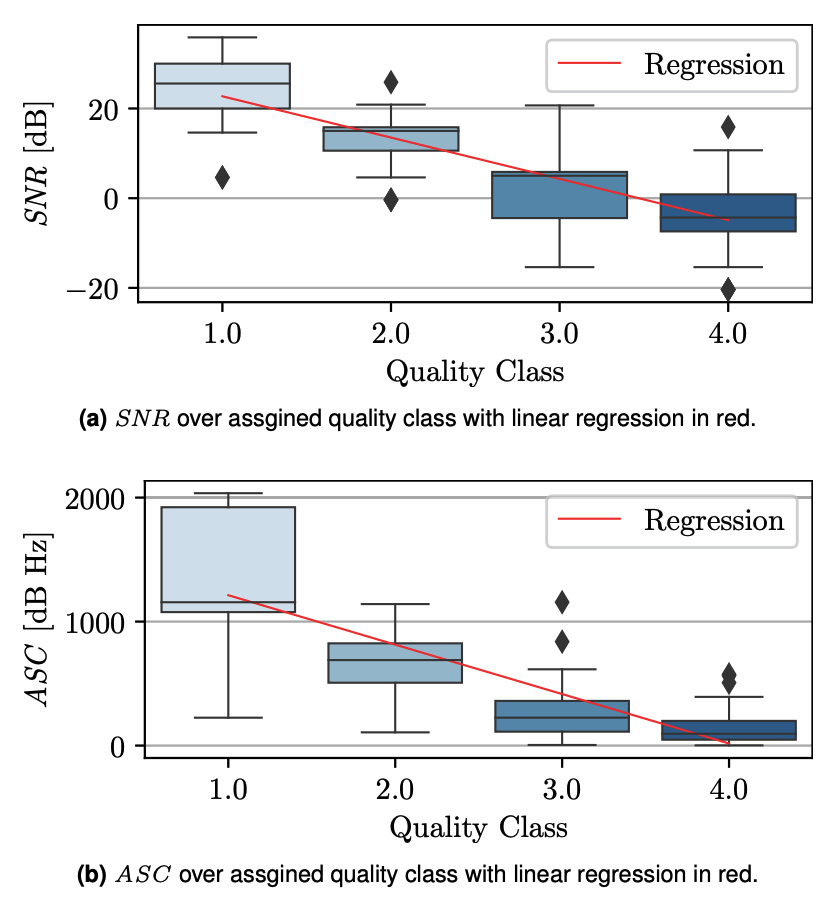Publications
-
Gradient-based Optimization of All-pass Filter Networks for Non-invasive Electroanatomical Mapping
Authors: Erik Engelhardt, Johannes Hoffmann, Moritz Boueke, Lukas Elsner, Marius Leye, Norbert Frey, Gerhard Schmidt
Publication Date: 2025-07-11
Venue: IEEE Access
DOI: 10.1109/ACCESS.2025.3588293
Keywords: All-pass Filter Networks, Gradient Descent Optimization, Cardiac Propagation Velocity, Non-invasive Electroanatomical Mapping, Magnetocardiography, Computational Modeling
Abstract: We propose interconnected all-pass filter networks as a novel approach for non-invasive electroanatomical mapping, addressing the fundamental challenge of accurately representing continuous propagation velocities in cardiac arrhythmia localization. Current methods either sacrifice precision with discrete delays or require computationally intensive biophysical models that limit clinical applicability. Our gradient-based optimization approach demonstrates potential for more precise and computationally efficient cardiac mapping without invasive procedures.
BibTeX Citation
@article{Engelhardt2025Gradient, title={Gradient-based Optimization of All-pass Filter Networks for Non-invasive Electroanatomical Mapping}, author={Engelhardt, Erik and Hoffmann, Johannes and Boueke, Moritz and Elsner, Lukas and Leye, Marius and Frey, Norbert and Schmidt, Gerhard}, journal={IEEE Access}, year={2025}, doi={10.1109/ACCESS.2025.3588293} } -
Pilot Study: Step Width Estimation with Body-Worn Magnetoelectric Sensors
Authors: Johannes Hoffmann, Erik Engelhardt, Moritz Boueke, Julius Welzel, Clint Hansen, Walter Maetzler, Gerhard Schmidt
Publication Date: 2025-05-28
Venue: Sensors
DOI: 10.3390/s25113390
Keywords: gait analysis, gait variability, magnetic motion tracking, magnetoelectric sensor, technical validation
Abstract: We present a magnetic estimation approach using shank-worn magnetoelectric sensors to measure step width, a key clinical motor marker for gait stability assessment. By comparing estimates to optical motion capture references during treadmill walking with eight healthy participants, we achieved high accuracy with mean absolute error ≤1 cm for step width and <0.1 cm for step width variability. The method demonstrates strong potential for wearable gait stability assessment in real-world conditions where traditional laboratory systems are impractical.
BibTeX Citation
@article{Hoffmann2025PilotStudy, title={Pilot Study: Step Width Estimation with Body-Worn Magnetoelectric Sensors}, author={Hoffmann, Johannes and Engelhardt, Erik and Boueke, Moritz and Welzel, Julius and Hansen, Clint and Maetzler, Walter and Schmidt, Gerhard}, journal={Sensors}, volume={25}, number={11}, pages={3390}, year={2025}, doi={10.3390/s25113390} }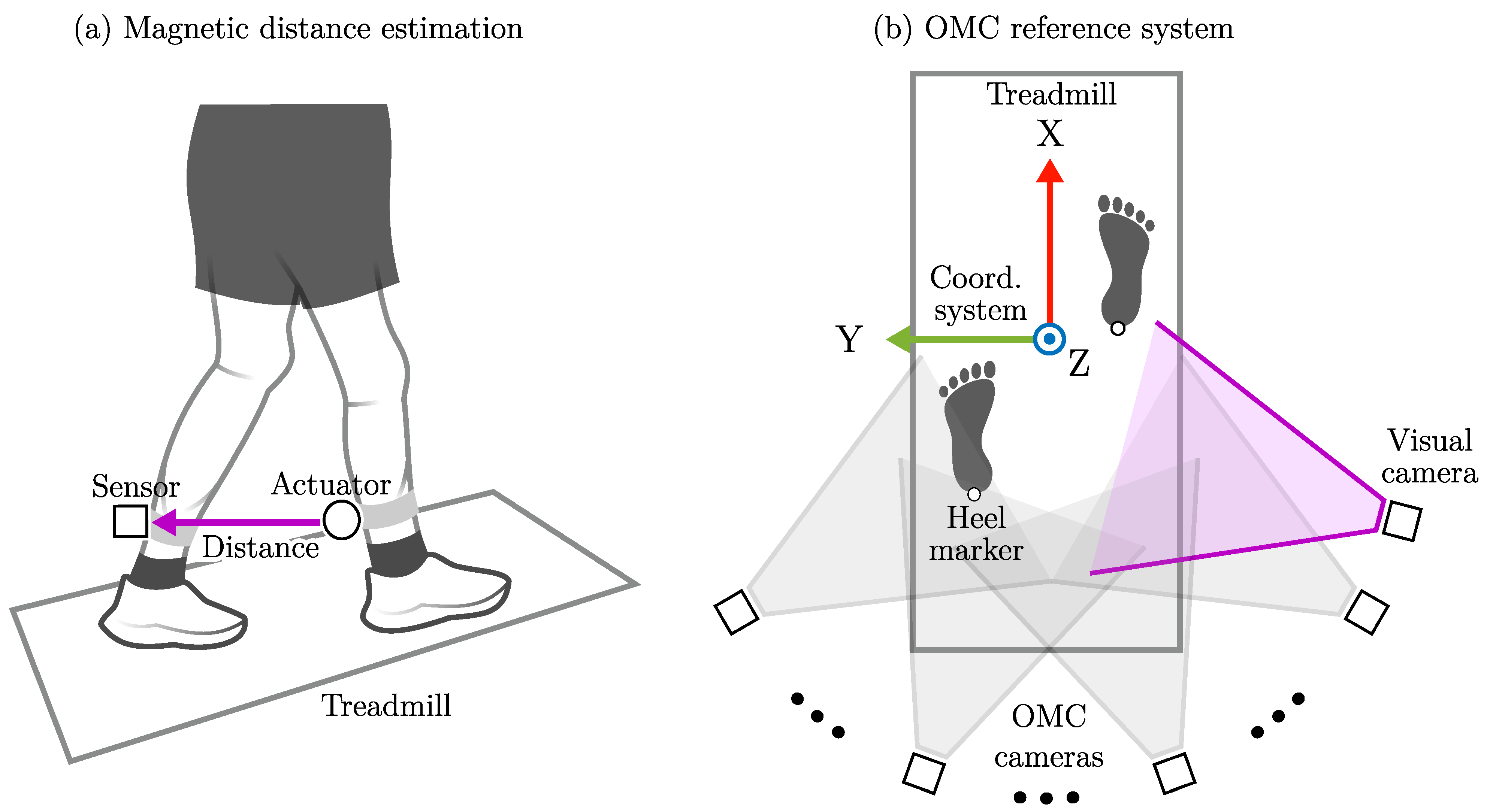
-
A Magnetoelectric Distance Estimation System for Relative Human Motion Tracking
Authors: Johannes Hoffmann, Henrik Wolframm, Erik Engelhardt, Moritz Boueke, Tobias Schmidt, Julius Welzel, Michael Höft, Walter Maetzler, Gerhard Schmidt
Publication Date: 2025-01-16
Venue: Sensors
DOI: 10.3390/s25020495
Keywords: digital signal processing, gait analysis, magnetic motion tracking, magnetoelectric sensor, technical validation
Abstract: We present a distributed magnetic tracking system based on novel magnetoelectric (ME) sensors for clinical motion analysis, addressing the need for accurate relative tracking of extremities in mobility assessment. The system employs body-worn magnetic actuators and ME sensor arrays with comprehensive signal processing and gradient descent-based calibration. In pilot studies evaluating motion tracking during treadmill walking, we achieved centimeter-level accuracy with a mean absolute distance error of 0.4 cm at distances up to 60 cm, demonstrating the potential for clinical gait parameter assessment.
BibTeX Citation
@article{Hoffmann2025, title = {A Magnetoelectric Distance Estimation System for Relative Human Motion Tracking}, author = {Hoffmann, Johannes and Wolframm, Henrik and Engelhardt, Erik and Boueke, Moritz and Schmidt, Tobias and Welzel, Julius and Höft, Michael and Maetzler, Walter and Schmidt, Gerhard}, journal = {Sensors}, year = {2025}, volume = {25}, number = {2}, pages = {495}, doi = {10.3390/s25020495} }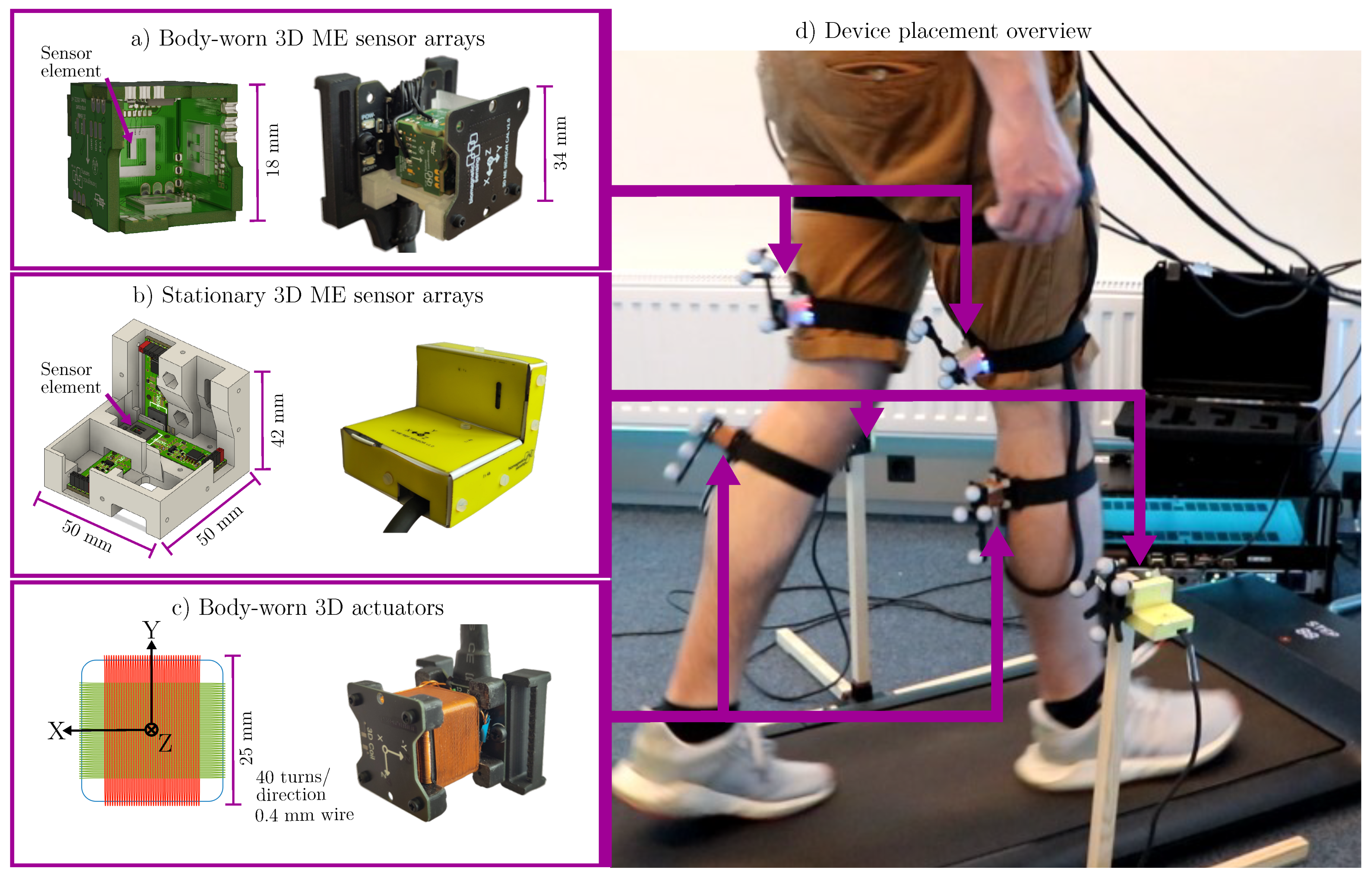
-
Enhancing Non-Invasive Electroanatomical Mapping with Dynamic Sensor Arrays
Authors: Erik Engelhardt, Johannes Hoffmann, Moritz Boueke, Norbert Frey, Gerhard Schmidt
Publication Date: 2024-10-20
Venue: 2024 IEEE SENSORS
DOI: 10.1109/SENSORS60989.2024.10784742
Keywords: Non-invasive electroanatomical mapping, Dynamic sensor arrays, Magnetocardiography, Cardiac diagnostics, Biomedical engineering
Abstract: We introduce a novel approach to non-invasive electroanatomical mapping using dynamic sensor arrays that reposition between heartbeats to enhance spatial resolution without increasing sensor count. Our simulated dynamic array with six motion steps per axis significantly improved performance metrics, achieving Dice scores of 0.95 (vs. 0.82 static), precision of 0.98 (vs. 0.95 static), and recall of 0.92 (vs. 0.73 static). This approach could substantially reduce cost and improve performance of non-invasive electroanatomical mapping..
BibTeX Citation
@inproceedings{Engelhardt2024Enhancing, title={Enhancing Non-Invasive Electroanatomical Mapping with Dynamic Sensor Arrays}, author={Engelhardt, Erik and Hoffmann, Johannes and Boueke, Moritz and Frey, Norbert and Schmidt, Gerhard}, booktitle={2024 IEEE SENSORS}, pages={1--4}, year={2024}, organization={IEEE}, doi={10.1109/SENSORS60989.2024.10784742} }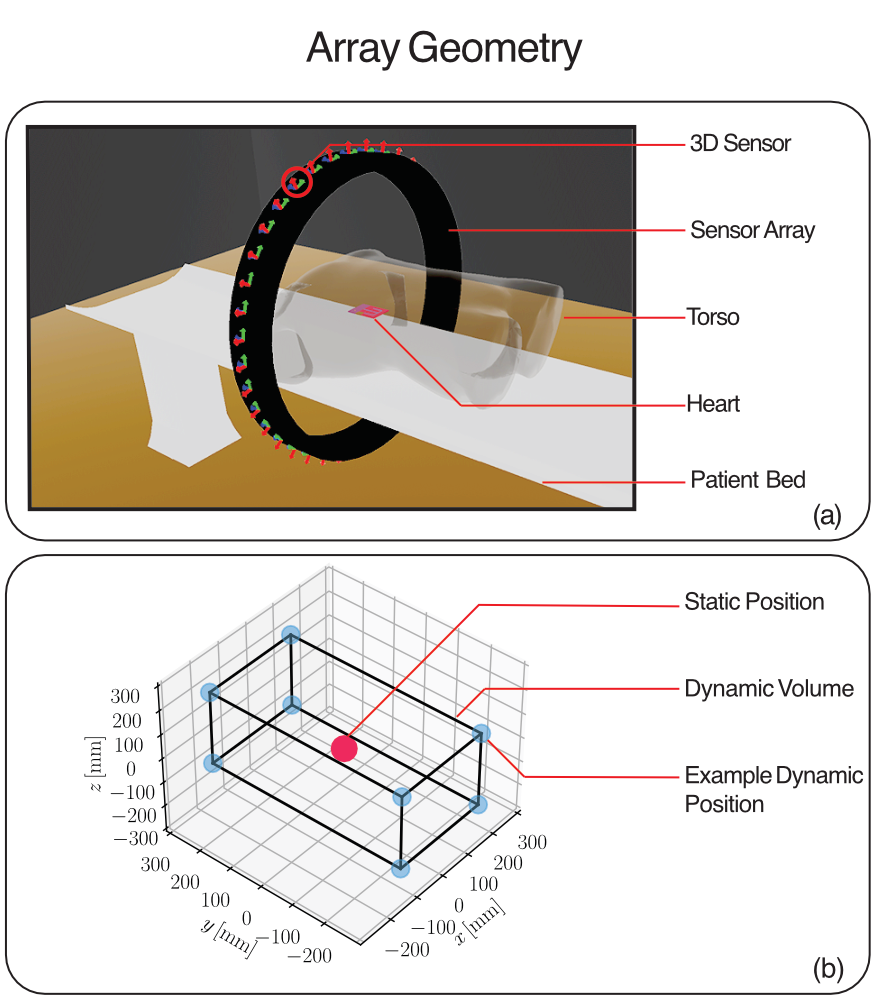
-
Proof of Principle: Full 6D Point-to-Point Motion Tracking with Magnetoelectric Sensors
Authors: Johannes Hoffmann, Moritz Boueke, Erik Engelhardt, Tobias Schmidt, Clint Hansen, Julius Welzel, Walter Maetzler, Gerhard Schmidt
Publication Date: 2024-10-20
Venue: 2024 IEEE SENSORS
DOI: 10.1109/SENSORS60989.2024.10785199
Keywords: 6D motion sensing, biomedical applications, dipole field, inverse solution, magnetic localization, magnetic tracking, magnetoelectric sensors, real-time signal processing
Abstract: We demonstrate full 6D motion tracking using an early-stage triaxial magnetoelectric sensor array, addressing limitations in applications with restricted mobility or non-line-of-sight conditions. By combining a real-time magnetic signal preprocessing pipeline with a revised position and orientation estimation algorithm, we achieved tracking at ranges up to 50 cm with average errors of 1.4 cm for distance, 6.4 cm for position, and 27° for orientation. This proof of principle showcases the potential of magnetoelectric sensors for robust motion tracking in challenging environments.
BibTeX Citation
@inproceedings{Hoffmann2024Proof, title={Proof of Principle: Full 6D Point-to-Point Motion Tracking with Magnetoelectric Sensors}, author={Hoffmann, Johannes and Boueke, Moritz and Engelhardt, Erik and Schmidt, Tobias and Hansen, Clint and Welzel, Julius and Maetzler, Walter and Schmidt, Gerhard}, booktitle={2024 IEEE SENSORS}, pages={1--4}, year={2024}, organization={IEEE}, doi={10.1109/SENSORS60989.2024.10785199} }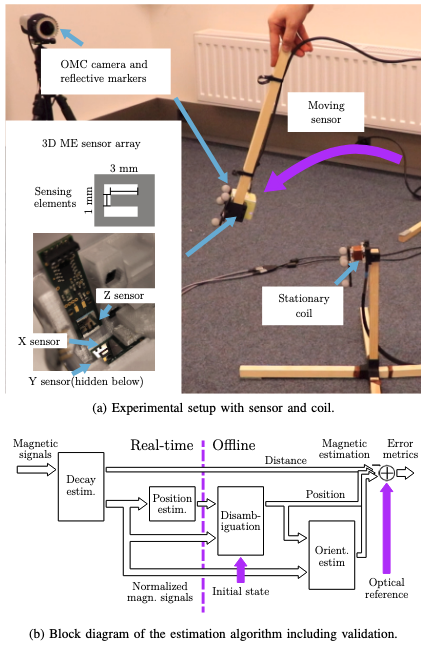
-
Investigation of Converse Magnetoelectric Thin-Film Sensors for Magnetocardiography
Authors: Eric Elzenheimer, Patrick Hayes, Lars Thormählen, Erik Engelhardt, Adrian Zaman, Eckhard Quandt, Norbert Frey, Michael Höft, Gerhard Schmidt
Publication Date: 2023-13-15
Venue: IEEE Sensors
DOI: 10.1109/JSEN.2023.3237910
Keywords: Sensors, Magnetoelelectric effects, Magnetic sensors, Magnetostriction, Magnetic shielding, Magnetic resonance, Magnetic noise
Abstract: In this paper, we highlight the development of thin-film magnetoelectric (ME) sensors as promising candidates for biomagnetic sensing, specifically in magnetocardiography (MCG). In our pilot study with a healthy volunteer in a magnetically shielded chamber, we applied an ME prototype (converse ME thin-film sensors) for the first time. Our sensor achieved a noise amplitude spectral density below 20 pT/√Hz at 10 Hz using a sophisticated magnetic layer system. We successfully detected the magnetic equivalent of a human R wave within a one-minute measurement period, demonstrating the potential of ME sensors for non-invasive cardiovascular applications.
BibTeX Citation
@article{elzenheimer2023investigation, title={Investigation of converse magnetoelectric thin-film sensors for magnetocardiography}, author={Elzenheimer, Eric and Hayes, Patrick and Thorm{\"a}hlen, Lars and Engelhardt, Erik and Zaman, Adrian and Quandt, Eckhard and Frey, Norbert and H{\"o}ft, Michael and Schmidt, Gerhard}, journal={IEEE Sensors Journal}, volume={23}, number={6}, pages={5660--5669}, year={2023}, publisher={IEEE} doi={10.1109/JSEN.2023.3237910} }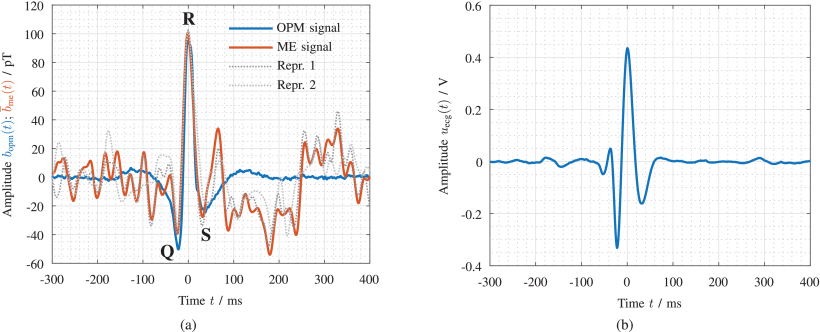
-
Non-Invasive Electroanatomical Mapping: A State-Space Approach for Myocardial Current Density Estimation
Authors: Erik Engelhardt, Eric Elzenheimer, Johannes Hoffmann, Christy Meledeth, Norbert Frey, Gerhard Schmidt
Publication Date: 2023-12-16
Venue: Bioengineering
DOI: 10.3390/bioengineering10121432
Keywords: Biomagnetism, Magnetocardiography, Non-invasive cardiac diagnostics, Kalman filter, Gradient descent optimization
Abstract: We introduce a new system state-based method for non-invasively estimating the electrical activity of the human heart using magnetocardiographic (MCG) measurements. Our algorithm employs a Kalman filter and gradient descent optimization to learn cardiac propagation paths, potentially reducing patient risks associated with invasive procedures and improving treatment planning.
BibTeX Citation
@article{engelhardt_noninvasive_2023, title={Non-Invasive Electroanatomical Mapping: A State-Space Approach for Myocardial Current Density Estimation}, author={Engelhardt, Erik and Elzenheimer, Eric and Hoffmann, Johannes and Meledeth, Christy and Frey, Norbert and Schmidt, Gerhard}, journal={Bioengineering}, volume={10}, number={12}, pages={1432}, year={2023}, publisher={MDPI}, doi = {10.3390/bioengineering10121432} }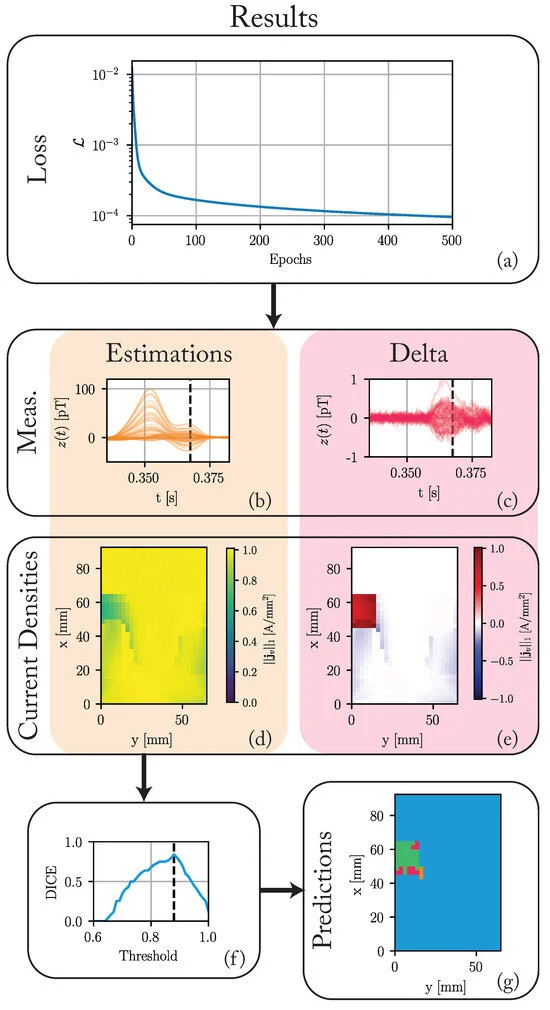
-
Kiel Cardio Database
Authors: Erik Engelhardt, Norbert Frey, Gerhard Schmidt
Publication Date: 2023-12-15
Venue: PhysioNet
DOI: 10.13026/q6r2-zz68
Keywords: Database, Magnetocardiography, Optically Pumped Magnetometer
Abstract: In this paper, we present the Kiel Cardio Database, containing magnetocardiography (MCG) measurements from seven healthy male volunteers recorded using QuSpin QZFM Gen 1 sensors in a magnetically shielded chamber. By making this dataset publicly available, we aim to enable researchers without access to specialized equipment to advance MCG research.
BibTeX Citation
@misc{engelhardt_kiel_2023, title = {Kiel Cardio Database}, url = {https://physionet.org/content/kiel-cardio/1.0.0/}, doi = {10.13026/Q6R2-ZZ68}, publisher = {PhysioNet}, author = {Engelhardt, Erik and Frey, Norbert and Schmidt, Gerhard}, }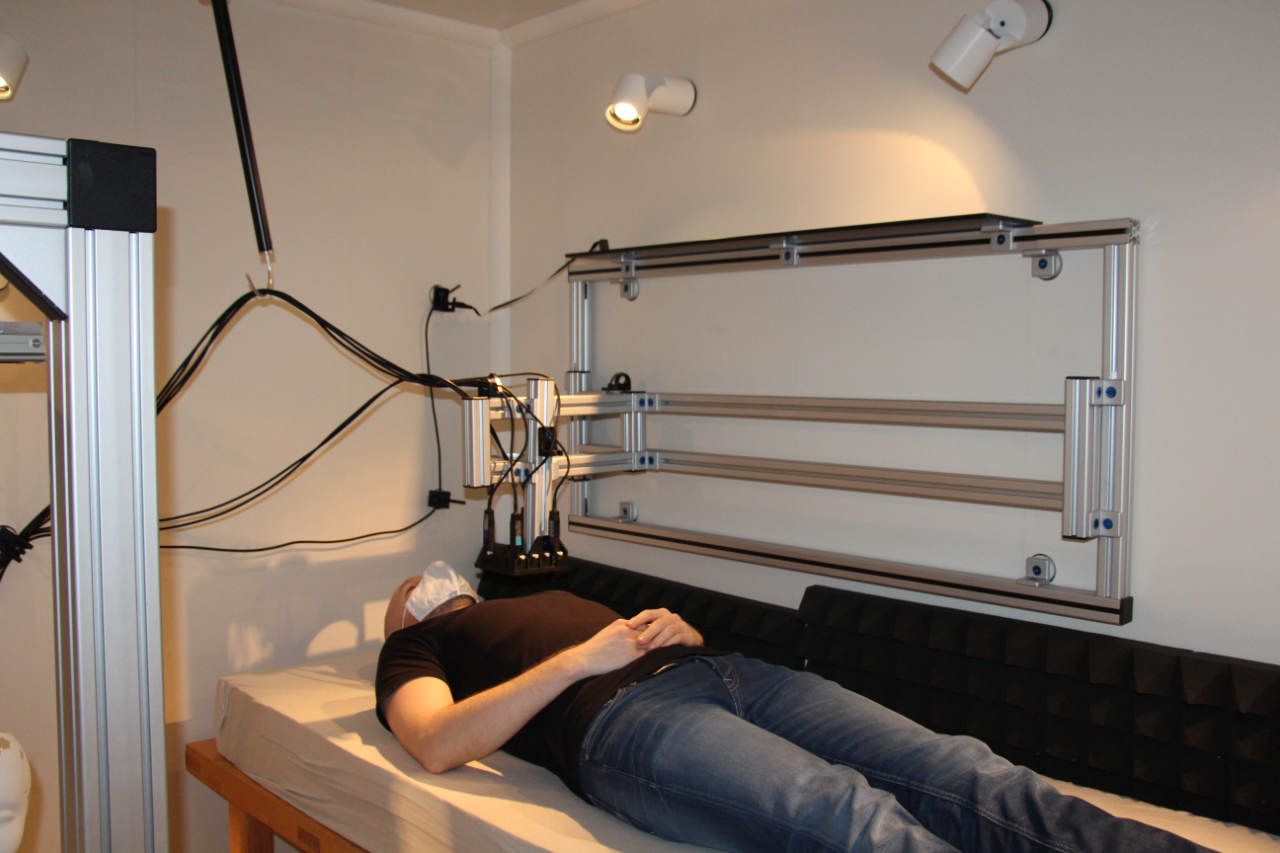
-
A Concept for Myocardial Current Density Estimation with Magnetoelectric Sensors
Authors: Erik Engelhardt, Eric Elzenheimer, Johannes Hoffmann, Tobias Schmidt, Adrian Zaman, Norbert Frey, Gerhard Schmidt
Publication Date: 2023-09-20
Venue: Current Directions in Biomedical Engineering
DOI: 10.1515/cdbme-2023-1023
Keywords: Biomagnetism, Magnetocardiography, Magnetoelectric sensors, Noninvasive cardiac diagnostics
Abstract: We present a novel noninvasive approach to estimate cardiac current densities using magnetocardiography (MCG). Our algorithm utilizes nested optimization and first-order Thiran all-pass filters to model current propagation between equally-sized myocardial voxels, showing potential to complement or replace invasive catheter-based procedures for localizing arrhythmogenic tissue.
BibTeX Citation
@inproceedings{engelhardt_concept_2023, title={A Concept for Myocardial Current Density Estimation with Magnetoelectric Sensors}, author={Engelhardt, Erik and Elzenheimer, Eric and Hoffman, Johannes and Schmidt, Tobias and Zaman, Adrian and Frey, Norbert and Schmidt, Gerhard}, booktitle={Current Directions in Biomedical Engineering}, volume={9}, number={1}, pages={89--92}, year={2023}, organization={De Gruyter} doi = {10.1515/cdbme-2023-1023} }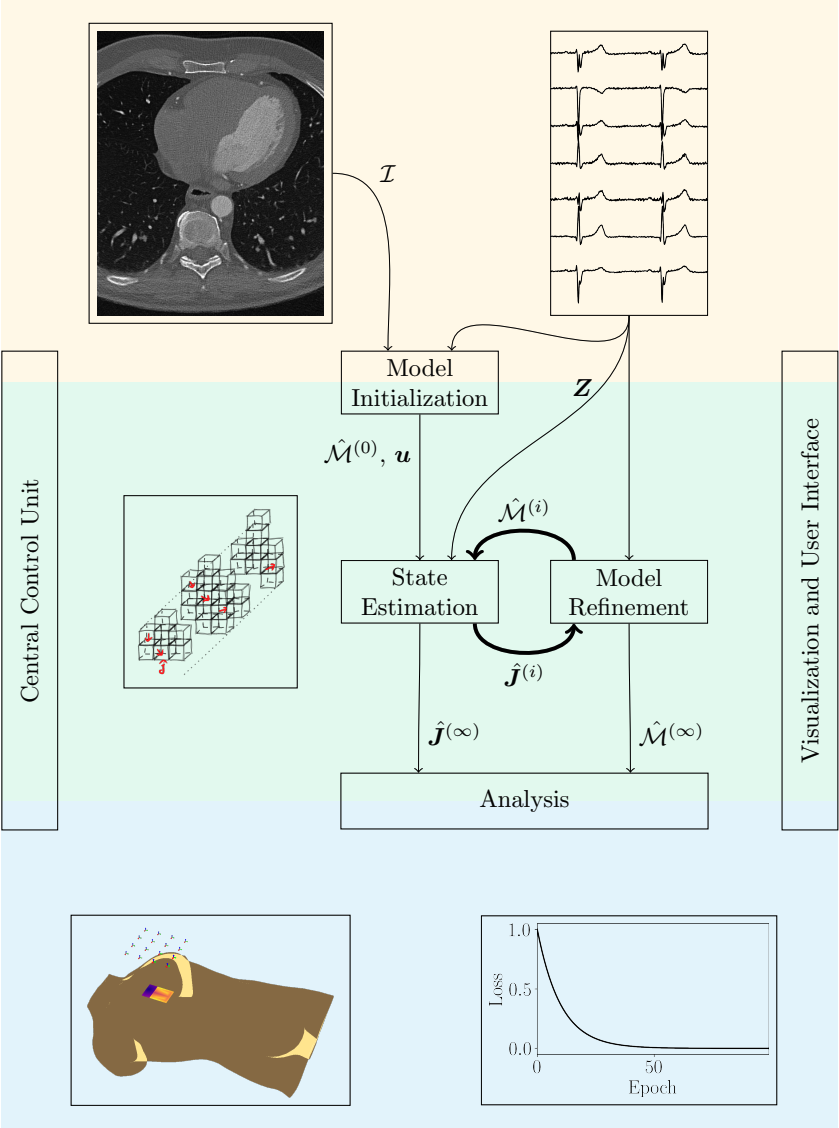
-
Designing and Validating Magnetic Motion Sensing Approaches with a Real-time Simulation Pipeline
Authors: Johnanes Hoffmann, Christin Bald, Tobias Schmidt, Moritz Boueke, Erik Engelhardt, Karolin Krüger, Erik Elzenheimer, Clint Hansen, Walter Maetzler, Gerhard Schmidt
Publication Date: 2023-09-20
Venue: Current Directions in Biomedical Engineering
DOI: 10.1515/cdbme-2023-1114
Keywords: Ditigal twin, Localization, Magnetic methods, Magnetoelectric sensors, Motion sensing
Abstract: We introduce a comprehensive simulation pipeline based on the digital twin concept to facilitate the design and validation of magnetic motion sensing systems. Our approach addresses the hardware and software challenges of establishing setups from scratch, enabling non-contact 3D tracking of position and orientation with applications in human movement analysis.
BibTeX Citation
@inproceedings{hoffmann_designing_2023, title={Designing and Validating Magnetic Motion Sensing Approaches with a Real-time Simulation Pipeline}, author={Hoffmann, Johannes and Bald, Christin and Schmidt, Tobias and Boueke, Moritz and Engelhardt, Erik and Kr{\"u}ger, Karolin and Elzenheimer, Eric and Hansen, Clint and Maetzler, Walter and Schmidt, Gerhard}, booktitle={Current Directions in Biomedical Engineering}, volume={9}, number={1}, pages={455--458}, year={2023}, organization={De Gruyter} doi = {10.1515/cdbme-2023-1114} }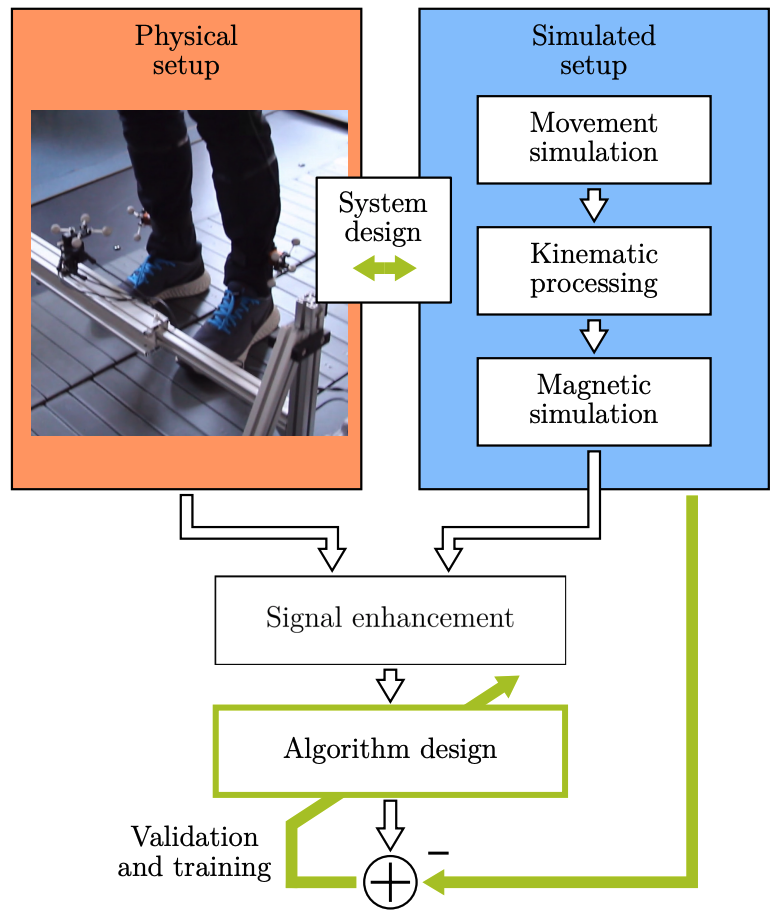
-
Investigation of Converse Magnetoelectric Thin-Film Sensors for Magnetocardiography
Authors: Eric Elzenheimer, Christin Bald, Erik Engelhardt, Johannes Hoffmann, Patrick Hayes, Johan Arbustini, Andreas Bahr, Eckhard Quandt, Michael Höft, Gerhard Schmidt
Publication Date: 2022-12-10
Venue: Sensors
DOI: 10.3390/s22031018
Keywords: Application specific signal evaluation, Magnetoelectric sensors, Quantitative sensor system characterization, Sensor system performance
Abstract: We highlight metrics for quantitatively characterizing thin-film magnetoelectric (ME) sensor systems and their output signals in biomagnetism. We present an ME sensor system evaluation scheme performed under reproducible conditions, applying it to two ME sensors—a resonant ME sensor and an electrically modulated ME sensor. By introducing an application-specific capacity (ASC) as a figure of merit and comparing signal-to-noise ratios (SNRs), we demonstrate that the electrically modulated ME sensor is better suited for magnetocardiography (MCG) applications under ideal conditions. Our approach is transferable to other magnetic sensors and applications, aiding in the optimization and selection of sensor systems for medical use.
BibTeX Citation
@article{elzenheimer2022quantitative, title={Quantitative evaluation for magnetoelectric sensor systems in biomagnetic diagnostics}, author={Elzenheimer, Eric and Bald, Christin and Engelhardt, Erik and Hoffmann, Johannes and Hayes, Patrick and Arbustini, Johan and Bahr, Andreas and Quandt, Eckhard and H{\"o}ft, Michael and Schmidt, Gerhard}, journal={Sensors}, volume={22}, number={3}, pages={1018}, year={2022}, publisher={MDPI} doi={10.3390/s22031018} }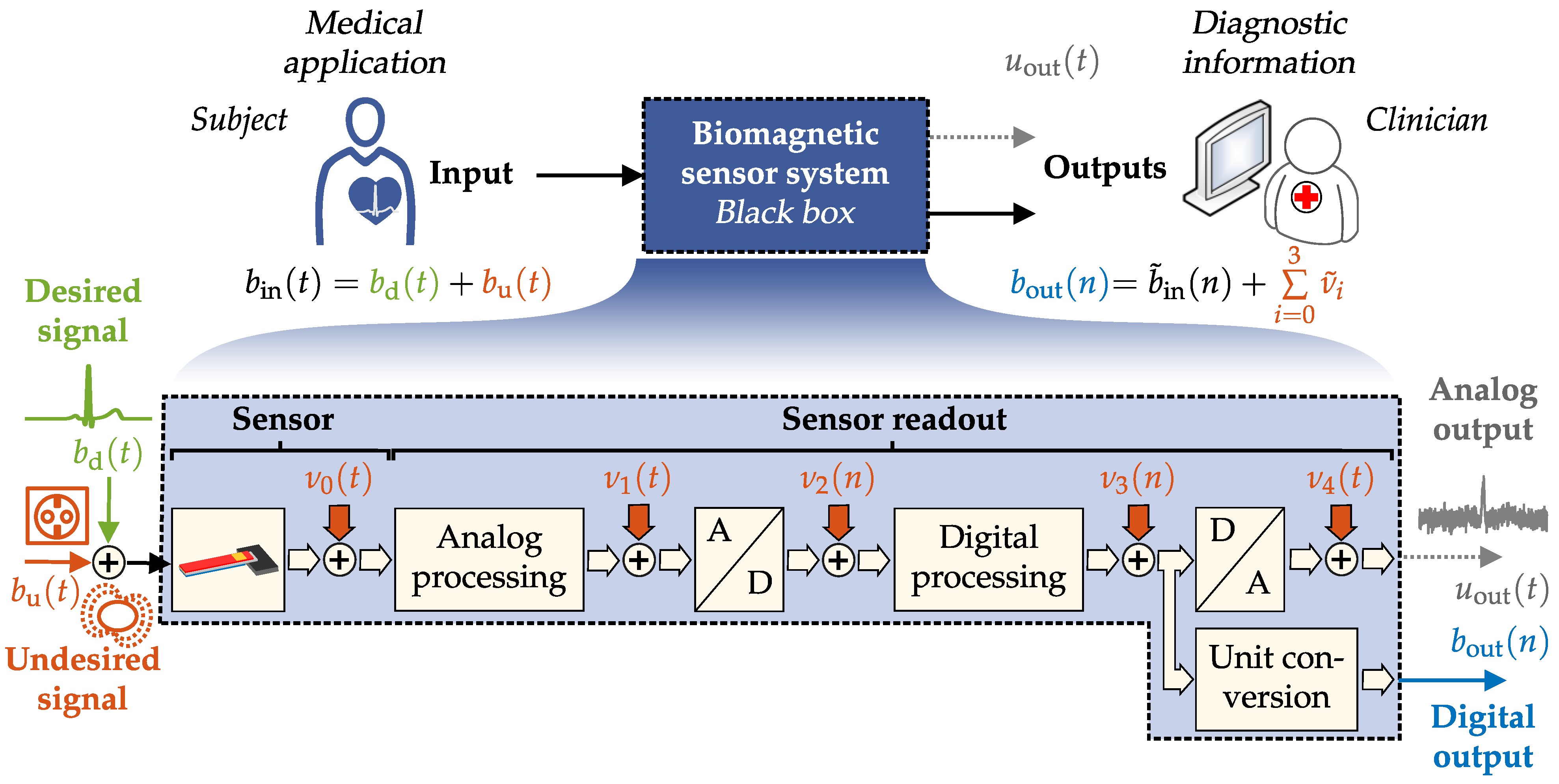
-
Towards Analytically Computable Quality Classes for MCG Sensor Systems
Authors: Erik Engelhardt, Adrian Zaman, Eric Elzenheimer, Norbert Frey, Gerhard Schmidt
Publication Date: 2022-09-02
Venue: Current Directions in Biomedical Engineering
DOI: 10.1515/cdbme-2022-1176
Keywords: MCG, ECG, Sensor system characterization, Sensor System Performance, Quality Classes, Biomagnetic sensors
Abstract: We investigate the relationship between quantitative signal quality metrics—specifically signal-to-noise ratio (SNR) and application-specific capacity (ASC)—and the subjective evaluations of cardiologists using magnetocardiography (MCG) signals. By defining four quality classes and comparing noisy prototype signals, we demonstrate that it is plausible to predict qualitative assessments from these quantitative metrics, which can help manufacturers optimize MCG sensor systems and assist users in selecting the most suitable equipment for their applications.
BibTeX Citation
@inproceedings{engelhardt_towards_2022, title={Towards analytically computable quality classes for MCG sensor systems}, author={Engelhardt, Erik and Zaman, Adrian and Elzenheimer, Eric and Frey, Norbert and Schmidt, Gerhard}, booktitle={Current Directions in Biomedical Engineering}, volume={8}, number={2}, pages={691--694}, year={2022}, organization={De Gruyter} doi={10.1515/cdbme-2022-1176} } }